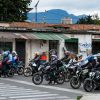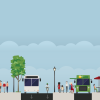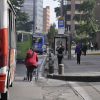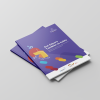From April 11 to 16, we had the opportunity to bring a group of people to visit the most important transport projects in Medellin, Bogota and Pereira. We went to all the existing mass-transit systems in these cities and rode bikes, visited public works… Anyway. If you are interested in participating in one of our next technical visits, you are welcome!
The experience of Bogota has served as a catalyst for future improvements in public space and transportation in developed or developing cities; at this moment Medellin is seen as an example of best practices. The main purpose of the visit was for all attendees to have a positive experience and to learn about urban transportation initiatives in Bogota, Medellin and Pereira, using the systems and interacting with their directors and operators, as well as local experts. It was structured in a way that participants could gather experiences and lessons to plan and implement similar projects in their cities.
The tour included visits to the different transport modes in Medellin, Pereira and Bogota, along with discussions with experts about made these cities renowned examples of urban mobility and social interaction. The attendees also enjoyed the ciclovía in Bogota.
The complete visit to Medellin, Pereira and Bogota included:
– Field visits to operating systems (Metroplus, Metro, Carro Cable, Escaleras Públicas, Transmilenio, Megabus)
– Site visits to operator warehouses and control centers.
– Field visits to non-motorized transport and complementary systems (ciclovía and ciclorruta networks in Bogota)
– Technical discussions with local experts
– Review sessions about technical discussions
– Supporting material with technical information about the projects and initiatives visited during the study tour.
The study tour was aimed at anyone interested in receiving detailed information about advances in urban transport related to urban development (consultants, policymakers, planners and students). Despacio was in charge of organizing the activities in the study tour and providing local transport, as well as suggesting possibilities for accommodation and travel.
The main themes of the visit were:
Urban Renewal:
Bogota and Medellin are known for their investments in urban renewal. The two cities have made great efforts to invest in public schools and libraries in poorer areas, showing an interest in offering high-quality spaces for their citizens (Biblioteca España in Medellin and El Tintal in Bogota).
Additionally, Medellin built large city parks where wealthier and poorer people in the city could enjoy the open air and have fun (Parque Explora).
These are successful examples of renewal of public space because they create greater access to programs where citizens can learn and develop abilities that generate enormous economic opportunities. These renewed spaces promote health through sports and recreation; they create opportunities for greater civic interactions, as well as supporting educational achievements.
Non-motorized transport:
Bogota is known in the region for its bike network of more than 370 km. Trips on bicycle increased from a modal share of 0.5% in 1998 to around 5% in 2013. In Medellin, the metropolitan region has directed its efforts to promoting the use of bicycles. In fact, they are developing studies for the Cycling Masterplan for the Metropolitan Region. They plan to extend the network, which is currently 25 km. It is worth noting that Medellin is the only city in Colombia that has a public bicycle system. It began in 2011 and runs from Monday to Friday.
Bicycle-related Sports and Recreation:
The Ciclovía is an event that began in Bogota around 1976 with the closing of a road. It is a weekly event on Sundays and holidays and extends over 120 km. More than 1.5 million go out every Sunday to enjoy the open streets biking, skating or simply walking.
Medellin has a Ciclovía that has existed for 20 years with an extensive 46 km of streets temporarily closed to cars. It connects different parts of the city, as well as other municipalities in the metropolitan region of the Valley of Aburrá. More than 85,000 people use it every week.
Advances in mass transit:
– Transmilenio: It is a BRT system that transports more than 1.9 million passengers every day and has transformed mobility in Bogota. It was constructed beginning in 1998 during the Peñalosa administration and was inaugurated in December 2000; it began to operate the 18th of that month. Phases 1 and 2 have a total of 84 km and 114 stations. Phase 3 comprises 36 km and 37 stations.
Mobility in Bogota before Transmilenio was in the hands of private operators running distinct services without organization. Bus drivers competed in the so-called “penny wars” which promoted violent behavior among divers, users and other actors. Transmilenio ended the roots of this war with the formalization of transit service. It improved user and driver conditions with its new infrastructure, reducing travel times and transforming citizens’ quality of life.
In terms of public space, the conditions of Bogota were precarious. Many plazas and other public spaces had been taken over by informal commerce. With the construction of Transmilenio, there was a significant effort to revitalize these public spaces through physical investment where conditions had deteriorated.
– SIT-VA (Sistema Integrado de Transporte del Valle de Aburrá): The metro system is the spine of the SITVA in Medellin and the municipalities of the Aburrá Valley. SITVA also comprises a cable car, MBRT, Metroplus and a public bicycle system.
- The metro has 55 stations in total and has operated for more than 15 years. Medellin is the only city in Colombia with a Metro.
- The Cable Car’s main goal is the improvement of mobility conditions for poor people in the city; it therefore has direct connections with the metro. It brings people from the poorest neighborhoods in the mountains around the city to the central valley. Because of this, it is considered an important and strong system.
- Metroplus is the BRT system of Medellin. It began December 22, 2011. It has a length of 12.5 km and transports around 52,000 passengers a day.
- The Electric Stairs were a particularly innovative project. They were constructed in a low-income neighborhood situated on the side of the mountain in Medellin. For people living in this area it was difficult to get to their houses; the neighborhood didn’t have sidewalks and during the rainy season, it was dangerous to climb the mountain due to the mud and falling water.
- Megabus is Pereira’s BRT system. It was the first system operating in a medium-sized city in Colombia. Today it carries around 100,000 passengers a day and its users consider an efficient system. It runs between two municipalities: Dos Quebradas and Pereira. There was a lot of investment to prepare and adapt the city center for the arrival of Megabus. Private cars were eliminated from a large portion of the center to give space to the BRT and sidewalks were widened to allow people to walk freely.









Comentarios recientes